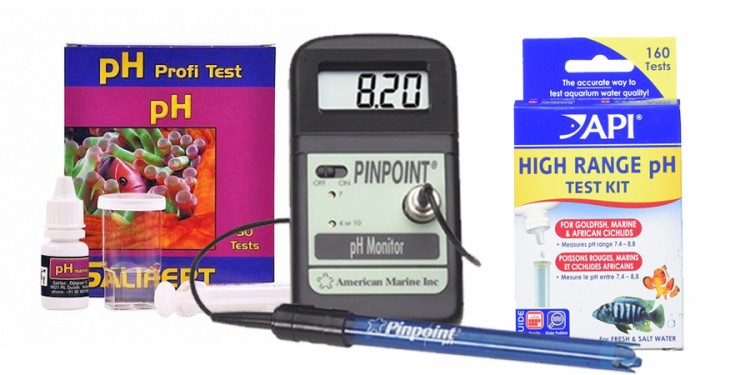What You Need to Know About Aquarium pH
- Nov 28, 2018
- PalaciosAn
- 751 0 0

pH stands for power of Hydrogen. The pH of the water measures the acidity or alkalinity of your water. The pH level is important to keep your fish healthy and in a reef aquarium, there are also studies showing some corals tend to grow or calcify quicker with higher levels of pH. So while some species require a specific pH range to stay healthy it's not ideal to try to chase a higher level of pH as long as you are within an acceptable range. Chasing and constantly changing the pH level will normally lead to stressing out the species in your tank and could even lead to death.
The pH scales from 0 to 14 with 0 being very acidic water, 14 is considered basic water and 7 is considered natural water.
When testing or adjusting pH you have to keep in mind that pH is not a static value, it actually changes throughout the day. So if your test shows you within the lower or higher end of the range try testing several hours later to see if you are still within range. If you have a pH monitor you will see that the pH level looks like a wave throughout the day with high and low points. When testing pH levels, I suggest trying to check the pH level at about the same time each day.
What is the proper pH level for a fish tank?
In a saltwater tank, you want to try to aim for a pH of about 8.0 but a stable range for pH is between 7.6 and 8.4 in a saltwater tank. In a freshwater tank lower levels of pH are more typically, most species allow for a suitable pH range for freshwater to be between 5.5 and 7.5 but you should look at your specific species needs how in freshwater they can range quite a bit from species to species.
How do I test the pH in my aquarium water?
- pH API Test Kit - Simple to use, inexpensive.
- pH API Test Strip - Simple to use, inexpensive.
- Salifert pH Test Kit - Simple to use, inexpensive.
- Digital pH Meter - Simple to use, inexpensive, instant, provides easy to read digital reading, no guessing at the pH value. Should be calibrated every few months to make sure they stay accurate.
- American Marine Pinpoint Digital pH Monitor - Simple to use, semi-expensive, provides real-time digital pH measurements. Should be calibrated every few months.
- Milwaukee pH Controller - Simple to use, a little expensive, provides easy to read real-time digital pH readings, no guessing at the pH value, professional grade pH monitor with a controllable outlet that can turn on when pH is low or high.
Do aquarium plants affect pH?
Plants and refugium can help pH levels, plants consume carbon dioxide and release oxygen which all affect your pH level. So live plants in your tank or if you run a refugium with live plants help increase your pH levels. If the plants are in your tank you do not have as many options but if you run a refugium you can run a reverse light schedule for the refugium. Normally at night, your pH level drops but if you have your refugium lights turn on when your tank lights turn off it will help stabilize your pH a bit more.
How do I adjust the pH in my fish tank?
Increasing pH levels
There may come a time where you will need to adjust your pH level. There are many different ways to adjust your pH levels. If you feel like pH levels are at a dangerous level a water change is always an ideal way to adjust your pH level.
Fresh air can make a big difference in your pH levels so simply opening a few windows can increase your pH levels due to a build up in carbon dioxide in your home. The carbon dioxide builds up in most cases are not dangerous to you but can cause lower pH levels in your aquarium. This is becoming more and more common due to home becoming more and more efficient. Leaving a window open is not always an option though. if you operate an aquarium with a protein skimmer, the skimmer has an air inlet valve, some people have run the valve to an external air source to allow fresh air into the skimmer which naturally increases the pH levels.
There are buffers on the market that can be purchased to help you hit your desired level such as Seachem Reef Buffer 250gram aims to adjust pH to 8.3 but in most cases it will get you to 8.0 - 8.2 pH - On a pinch, if you need to increase your pH levels you can use food grade baking soda, to give you an idea you can start by using 1 tablespoon of baking soda per 5 gallons of water. When using buffers to adjust your pH level also keep an eye on your Alkalinity levels.
With that said keep in mind that fish can get stressed out or even die with major swings in pH. If you need to make a large adjustment in pH its best to do it over an extended period of time to prevent any issues with the species in your tank.
Lowering pH Levels
If you feel like pH levels are at a dangerous level a water change is always an ideal way to adjust your pH level.
Here are some things you can add to a freshwater tank to naturally reduce pH levels. Driftwood can be almost like a natural filter that absorbs contaminants that could cause your pH to rise. Another option in a freshwater aquarium is adding peat moss, it will help naturally reduce your pH but will come with some trimming maintenance as it grows, and almond leaves can also reduce your pH and they also are known to have anti-inflammatory properties which also helps freshwater fish stay healthy.
You can use vinegar to reduce pH levels, to start with it is recommended to drop 1 mL per gallon of water. I would suggest cutting the dose in half and dosing twice.
When was the last time you tested your pH levels?
Add your tank to your My Tank Profile Page on Tank Facts and start logging your water parameters today for free. Keep a digital log of your water parameters and see trends in your water parameters.
Did we miss something? Do you have any suggestion on how you deal with pH if so comment below.






About author
I have been in the hobby for a while, my main focus is automation. I am interested in doing aquaponics in 2018.